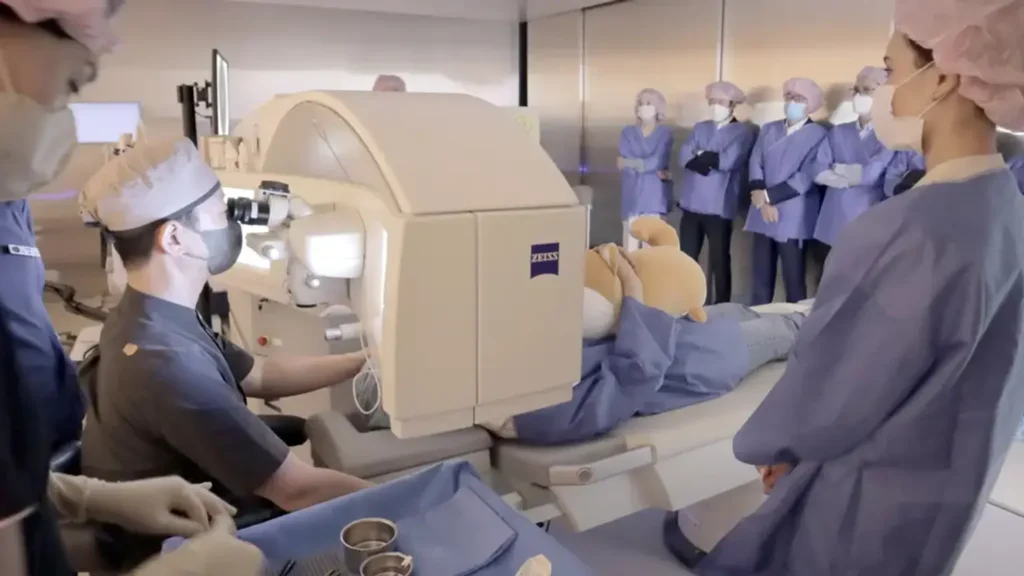Do your eyes constantly appear tired, droopy, or asymmetrical—even when you’re well-rested? Do you find yourself lifting your brows or tilting your head to see better? These could be signs of ptosis, a condition where the upper eyelid droops abnormally low. Fortunately, ptosis correction surgery can help you regain both a refreshed appearance and improved vision.
As one of the most commonly sought-after procedures in South Korea’s advanced cosmetic and oculoplastic surgery field, ptosis correction blends aesthetic precision with functional care—making it a top choice for medical tourists.
👁️ What Is Ptosis?
Ptosis (pronounced toe-sis) is a medical condition characterized by the drooping of the upper eyelid. This may affect one or both eyes and can range from mild sagging to complete eyelid obstruction.
There are two main types:
- Congenital ptosis: Present at birth due to underdeveloped levator muscles
- Acquired ptosis: Develops later in life from aging, nerve damage, eye trauma, or underlying health conditions
⚠️ Symptoms and Signs of Ptosis
- Upper eyelid drooping, covering part of the eye
- Uneven eyelid height (asymmetry)
- Constant sleepy or fatigued appearance
- Strained forehead muscles or brow elevation to improve vision
- Head tilting to see clearly
- In children: risk of lazy eye (amblyopia) or impaired visual development
🔍 Causes of Ptosis
- Aging (involutional ptosis): Most common in older adults
- Muscle or nerve damage (e.g., from trauma, eye surgery, or Bell’s palsy)
- Neurological conditions (e.g., myasthenia gravis, Horner’s syndrome)
- Congenital muscle weakness
- Prolonged contact lens wear (hard lenses may stretch eyelid tissues)
🛠️ What is Ptosis Correction Surgery?
Ptosis correction is a surgical procedure to raise the drooping upper eyelid, restoring a more open, alert eye appearance and improving the visual field.
Depending on the severity and cause of ptosis, surgeons use one of the following techniques:
1. Levator Advancement or Resection
- Tightens or shortens the levator palpebrae muscle
- Ideal for mild to moderate ptosis with good muscle function
2. Frontalis Sling Surgery
- Connects the eyelid to the frontalis muscle (forehead) using a sling (silicone or fascia)
- Recommended for severe ptosis or poor levator function
3. Müller’s Muscle-Conjunctival Resection (MMCR)
- Performed from inside the eyelid (scarless)
- Suitable for mild cases with a strong response to eye drop testing
✅ Benefits of Ptosis Correction
- Restores symmetry and a more youthful eye shape
- Improves peripheral vision and quality of sight
- Reduces forehead and brow strain
- Enhances self-confidence and facial expression
- Can be combined with other eye or facial procedures (e.g., double eyelid surgery, blepharoplasty)
🏥 Why Choose Korea for Ptosis Correction?
South Korea is a global leader in aesthetic and reconstructive eye surgeries. Korean oculoplastic surgeons are renowned for their precise techniques and natural-looking results.
Here’s why patients travel to Seoul for ptosis correction:
- 🎯 Advanced microsurgical techniques with minimal scarring
- 👨⚕️ Board-certified oculoplastic specialists
- 🖥️ 3D simulation and digital eye measurements
- 💉 Local or twilight sedation for maximum comfort
- 💬 English-speaking staff, medical tourism support
- 💸 Affordable packages with follow-up care included
⏳ What to Expect Before, During, and After Surgery
Pre-Surgery Consultation
- Visual field test and eyelid measurements
- Evaluation of levator muscle strength
- Customized surgical plan based on facial anatomy
During Surgery
- Typically performed under local anesthesia
- Procedure lasts 30–60 minutes per eye
- Hidden incisions in natural eyelid creases
Post-Surgery Recovery
- Swelling, bruising, and tightness for 5–10 days
- Sutures removed around day 5–7
- Return to work or school in 7–10 days
- Full healing and scar maturation over 1–3 months
🎯 Ideal Candidates for Ptosis Correction
You may benefit from ptosis correction if:
- You have drooping eyelids that obstruct your vision
- Your eyelids cause asymmetry or a tired appearance
- You experience brow or forehead tension from straining
- You want a functional and cosmetic improvement
- You’re in overall good health (non-smoker, no uncontrolled conditions)
👁️🗨️ Real Patient Experience
“I had mild ptosis on my left eye that made me look sleepy and asymmetrical in photos. After surgery in Seoul, my eyes look balanced and I feel more confident. The procedure was quick, recovery smooth, and I couldn’t be happier with the natural results.”
— Elina C., 35, Singapore
🔁 Ptosis Correction + Cosmetic Enhancements
For those interested in full aesthetic rejuvenation, ptosis correction is often paired with:
- Double eyelid surgery (for crease definition)
- Upper or lower blepharoplasty (to remove excess skin/fat)
- Canthoplasty or epicanthoplasty (to adjust eye shape or size)
Combining procedures can maximize aesthetic harmony and reduce overall recovery time.
💬 Frequently Asked Questions
Q: Will I have visible scars?
A: Incisions are hidden in the natural eyelid crease and typically heal with minimal scarring.
Q: Is the surgery permanent?
A: Results are long-lasting, but aging may cause future changes. Revision is rarely needed with skilled technique.
Q: Can children have ptosis surgery?
A: Yes. Pediatric ptosis surgery is common to prevent vision development issues, typically performed before age 5–6.
🌟 Reclaim Your Vision and Confidence
Ptosis correction surgery offers a transformative solution for anyone struggling with drooping eyelids, uneven eyes, or functional vision limitations. With precision, personalization, and safety at the forefront, Korea continues to lead in delivering natural, long-lasting outcomes for both cosmetic and medical needs.
Thinking about ptosis correction in Korea?
Book a consultation with a certified oculoplastic surgeon and discover how this procedure can help you look brighter, see clearer, and feel more confident—inside and out.




